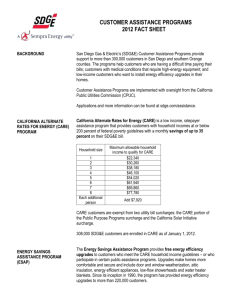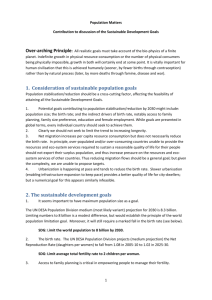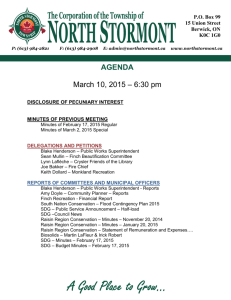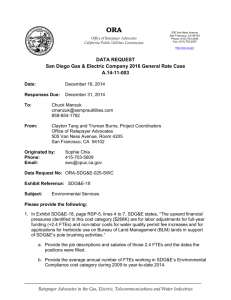Decision - National Energy Marketers Association
advertisement
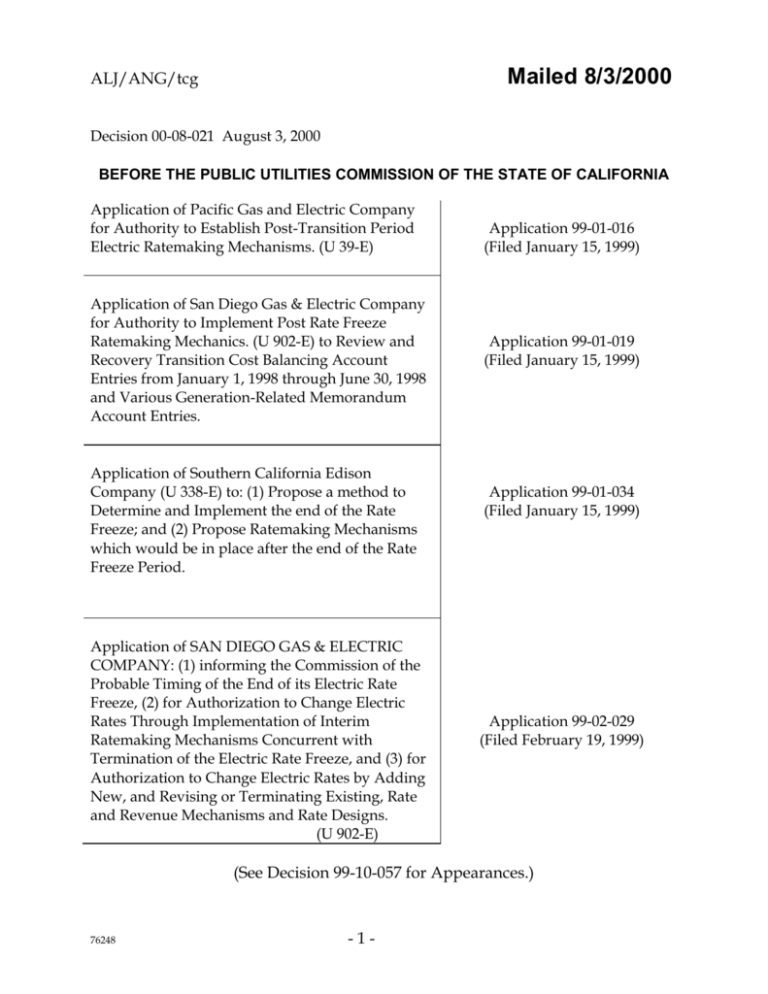
Mailed 8/3/2000 ALJ/ANG/tcg Decision 00-08-021 August 3, 2000 BEFORE THE PUBLIC UTILITIES COMMISSION OF THE STATE OF CALIFORNIA Application of Pacific Gas and Electric Company for Authority to Establish Post-Transition Period Electric Ratemaking Mechanisms. (U 39-E) Application of San Diego Gas & Electric Company for Authority to Implement Post Rate Freeze Ratemaking Mechanics. (U 902-E) to Review and Recovery Transition Cost Balancing Account Entries from January 1, 1998 through June 30, 1998 and Various Generation-Related Memorandum Account Entries. Application of Southern California Edison Company (U 338-E) to: (1) Propose a method to Determine and Implement the end of the Rate Freeze; and (2) Propose Ratemaking Mechanisms which would be in place after the end of the Rate Freeze Period. Application of SAN DIEGO GAS & ELECTRIC COMPANY: (1) informing the Commission of the Probable Timing of the End of its Electric Rate Freeze, (2) for Authorization to Change Electric Rates Through Implementation of Interim Ratemaking Mechanisms Concurrent with Termination of the Electric Rate Freeze, and (3) for Authorization to Change Electric Rates by Adding New, and Revising or Terminating Existing, Rate and Revenue Mechanisms and Rate Designs. (U 902-E) Application 99-01-016 (Filed January 15, 1999) Application 99-01-019 (Filed January 15, 1999) Application 99-01-034 (Filed January 15, 1999) Application 99-02-029 (Filed February 19, 1999) (See Decision 99-10-057 for Appearances.) 76248 -1- A.99-01-016 et al. ALJ/ANG/tcg ** OPINION REGARDING EMERGENCY MOTION FILED BY UTILITY CONSUMERS’ ACTION NETWORK Summary On July 6, 2000, the Utility Consumers’ Action Network (UCAN) filed and served an Emergency Petition to Modify Decision (D.) 99-05-051 (Petition). Consistent with the ruling of the assigned Administrative Law Judge (ALJ), parties filed and served responses on July 14.1 In this decision, we grant UCAN’s motion in part, deny it in part and implement several provisions designed to mitigate the summer rate spikes experienced by the customers of San Diego Gas & Electric Company (SDG&E). We have considered the proposed rate freeze. We have a duty to protect the public interest and do not intend to exacerbate future high energy bills by short-sighted actions now. Instead, we use the refunds of the rate reduction bond unrealized savings and the amortization of the Transition Cost Balancing Account (TCBA) to offset high bills. In addition, we recognize that wholesale electric markets are not workably competitive and begin an investigation to consider the impact of wholesale electric market on retail rates in SDG&E’s service territory. SDG&E filed and served its response on July 11. The Office of Ratepayer Advocates (ORA), Federal Executive Agencies (FEA), California Manufacturers & Technology Association (CMTA), the Alliance for Retail Markets (ARM), the California Power Exchange (CalPX), and the California Streetlighting Association (Cal-SLA) filed and served comments on July 14. SDG&E moved to file a supplemental response on July 14. That motion is granted. On July 17, The City of San Diego moved to intervene and file comments and Edison moved to file late-filed comments. Each of these motions is granted. On August 1, 2000, the Western Manufactured Housing Communities Association (WMHCA) filed a motion to intervene, and a motion to accept its late-filed comments to the draft decision and alternate. Due to the late timing of WMHCA’s comments, the Commission has not had adequate time to consider the motions and the comments to the draft decisions. Accordingly, the two WMHCA motions are denied. 1 -2- A.99-01-016 et al. ALJ/ANG/tcg ** UCAN’s Petition UCAN filed its Petition in response to considerably increased prices to SDG&E’s customers in June and July. A combination of heat waves across the West, a drop in reserves, and significantly increased demand have resulted in much higher wholesale energy costs. The Independent System Operator (ISO) has declared several emergencies this summer which have led to voluntary curtailments and rolling outages. The ISO Board of Governors recently voted to drop its price cap from $750 per megawatt2 to $500 per megawatt and then to $250 per megawatt in an effort to control prices. Because ratepayers in SDG&E’s service territory are no longer subject to a rate freeze, these consumers are subject to price volatility. UCAN characterizes the high rates faced by consumers as “dire and unprecedented” and requests that the Commission impose a summer rate freeze for residential, small commercial, and lighting customers for August, September, and October 2000 and allow SDG&E to establish a balancing account to track uncollected revenue. UCAN also requests that a follow-up proceeding be initiated in November 2000 to assess the size and recovery of the undercollection; to reconsider D.00-06-034 and approve the settlement related to procurement proposed by SDG&E, UCAN, and the Office of Ratepayer Advocates (ORA); to accelerate the process by which SDG&E can give residential and small commercial customers who so request special meters that allow them to receive price credits for not consuming electricity during peak periods; and to redirect In the ancillary services market, there are price caps for both capacity (megawatt) and imbalance energy (megawatt-hour). The same cap applies to both capacity and imbalance energy. 2 -3- A.99-01-016 et al. ALJ/ANG/tcg ** more of the $350 million in annual expenditures on energy efficiency programs to the San Diego area. In addition, UCAN requests that the Commission direct the Energy Division to conduct an investigation as to the cause of the summer price increase, with any generators found to have engaged in price gouging to be required to pay for a portion of the rate increase. In D.99-05-051, the Commission adopted a settlement regarding the end of SDG&E’s rate freeze. The settlement allowed SDG&E to cap its residential, small commercial, and lighting customers rates at levels not to exceed 112.5% of frozen electric rate levels on an average monthly basis for the months of July, August, and September, 1999. The settlement also provided that SDG&E would not propose a similar rate cap for the year 2000 in this proceeding. The Commission recently adopted D.00-06-034 in these proceedings. Pacific Gas and Electric Company (PG&E) proposed that price caps be adopted in order to mitigate the volatility in energy prices once the rate freeze ends. Southern California Edison Company (Edison) and SDG&E did not make similar proposals. With the exception of California Streetlighting Association (Cal-SLA), all other parties opposed price caps, stating that such devices would dilute market prices and distort market signals. In D.00-06-034, we determined that consumers must be aware of the price signals provided by the market and rejected PG&E’s rate capping proposal: We prefer that customers understand the impact of the market and the accompanying price signals. We call for the utilities and ESPs to provide the necessary customer education and information and recommend that hourly interval meters be installed whenever feasible. We also continue the balanced payment plan for residential and small commercial customers. We do not require that such plans be expanded to street lighting customers, but instead see this as an opportunity for the marketplace to offer solutions. (Id., mimeo. at p. 4.) -4- A.99-01-016 et al. ALJ/ANG/tcg ** UCAN did not address whether its proposal required a modification to D.00-06-034. The ALJ’s ruling specifically asked parties to comment on the need to modify that decision. SDG&E’s Responses In general, parties do not support UCAN’s proposal for price caps, but support other aspects of UCAN’s Petition. SDG&E proposes a series of shortterm and longer-term measures to address the impacts of rising rates on customers. SDG&E maintains that, as provided in D.00-06-034, residential and small commercial customers will receive refunds for the unrealized bond savings that resulted from the early end to the rate freeze. Customers will receive these refund checks in August and the typical residential customer will receive a refund of $260. The net effect of high summer bills and receipt of the refund check results in projected benefit of $90 to customers compared to last summer. SDG&E also proposes to develop installment plans for paying the summer bills, defer payment of half the electric bill until customers receive refund checks from the unrealized bond savings, and to expand marketing of balanced (or levelized) payment plans. SDG&E offers to act as an aggregator for customers to enable them to bid their load to the lowest-priced energy service provider (ESP) and joins UCAN in its call for an investigation of energy markets. SDG&E agrees that the Commission should expedite the deployment of real time meters and recommends that permitting and siting authority for new generators be streamlined and accelerated. SDG&E states that the rate freeze proposed by UCAN does not provide a solution to high electric prices – or to high customer utility bills, for that matter. SDG&E’s levelized payment plan (LPP) already allows consumers to smooth monthly bill fluctuations, with a true-up paid at the end of each calendar year. -5- A.99-01-016 et al. ALJ/ANG/tcg ** In contrast, SDG&E believes that UCAN’s proposal will encourage customers to consume more electricity during peak demand, rather than less, because regulation will insulate customers from the market. In addition, UCAN’s proposal could lead to higher winter bills, because ratepayers will be paying for the rate deferral at a time when natural gas usage and bills are high. SDG&E states that adopting UCAN’s proposal requires a modification of D.00-06-034 and that cannot be done without providing parties “notice and an opportunity to be heard as provided in the case of complaints,” as is required by Pub. Util. Code § 1708.3 SDG&E specifically calls for evidentiary hearings to determine the total amount of energy costs to be deferred, how the shortfall would be paid for and amortized, and the impacts on customers. In its supplemental response, SDG&E proposes an immediate summer bill credit for all customers in addition to the bond refund that residential and small commercial customers receive. SDG&E proposes that the overcollection resulting from recovery of its ongoing transition costs be credited to customers over August and September. Transition costs and related revenues are tracked in the Transition Cost Balancing Account (TCBA). As of July 13, SDG&E calculates that its TCBA is overcollected by $90 million. As of August 1, SDG&E expects the overcollection to be approximately $100 million. Normally, this overcollection would be amortized into rates in 2001. Because the commodity prices exceed the fixed prices for energy of SDG&E’s portion of the San Onofre Nuclear Generating Station (SONGS) (determined to be approximately 4.3 cents per kilowatt-hour (kWh), SONGS 3 Statutory references are to the Pub. Util. Code, unless otherwise noted. -6- A.99-01-016 et al. ALJ/ANG/tcg ** energy has generated higher revenues than anticipated.4 Similarly, expenses (or above-market costs) and revenues are calculated for SDG&E’s Qualifying Facilities (QF) contracts and its long-term contracts with Portland General Electric and Public Service of New Mexico. The Competition Transition Charge (CTC) rate component was set for 2000 using certain PX forecasts that have turned out to be lower than the actual PX prices. There are no above market costs for these power purchase contracts for this time frame and this results in accrued revenue to offset transition cost recovery.5 As of May 31, SDG&E reports that the overcollected balance in the TCBA was $38.4 million; when SDG&E closed its books for June, the balance was approximately $90 million. Thus, the commodity price spikes have caused this account to more than double in a matter of weeks. SDG&E projects that with current PX prices, the TCBA overcollection will be approximately $100 million on July 31. Other Parties’ Positions FEA and CMTA do not oppose UCAN’s rate cap so long as any customer not subject to the cap does not have to bear any costs associated with the recovery of such a rate deferral. CMTA, however, believes that the LLP provide the same benefits without impacting market signals. The TCBA is a complicated balancing account composed of several sub-accounts and memorandum accounts. Costs and revenues related to SONGS are tracked in a subaccount. When revenues exceed costs, those revenues are credited to the TCBA and offset transition cost recovery. When costs exceed revenues, those costs are debited to the TCBA and increase the ongoing transition costs to be recovered. 4 Like SONGS, costs and revenues related to power purchase contracts are calculated in a sub-account, as explained in Footnote 4. 5 -7- A.99-01-016 et al. ALJ/ANG/tcg ** ORA agrees that without a significant disallowance of any shortfall or amortization over a lengthy period, UCAN’s proposal will only forestall, rather than eliminate, high bills for SDG&E customers. ORA agrees with SDG&E’s analysis that increased prices for gas and normal increased natural gas consumption in the winter, along with amortization of an electric price undercollection will lead to significantly higher combined electric and gas bills and associated customer complaints. ORA believes that the refund of unrealized rate reduction bond savings will help to mitigate the rate shock to small customers. ORA agrees with SDG&E’s assessment that the average SDG&E residential customer will end up about $90 ahead of last summer, in terms of cash flow. While ORA agrees that a rate cap is contrary to D.00-06-034 and that consumers should have the opportunity to respond to price signals, ORA is also concerned that the market is not workably competitive. Thus, ORA supports both UCAN and SDG&E’s call for an investigation into the commodity price increase. ORA, however, recommends that the Attorney General’s office is better suited to conduct such an investigation, because the Commission does not have jurisdiction over the merchant generators. ORA points out that PG&E and Edison have the incentive to maximize headroom under the rate freeze rather than to drive up prices. ORA is also hesitant regarding SDG&E’s proposal for universal installation of real-time meters, because both cost-effectiveness and impact on competition should be considered. ORA supports expanded or redirected energy efficiency funds but will respond to the utilities’ proposals in Application (A.) 99-09-049 et al., as called for in D.00-07-017. ORA counsels against SDG&E acting as an aggregator for small customers, since this may again impact competition in a negative fashion. -8- A.99-01-016 et al. ALJ/ANG/tcg ** ORA recommends that the Commission open a quasi-legislative investigation or rulemaking into facilitating more stable rate options to customers and rate design for default service. PG&E maintains that instituting a rate cap for SDG&E requires a specific fact-finding inquiry, but states that the rate capping proposal made in the posttransition ratemaking proceeding is not designed to address the issues at hand. Both ARM and the CalPX suggest that hedging (i.e., allowing participants to manage risk through purchases and sales of electricity and energy-related products on a forward basis) will help to solve this problem. Both parties note that SDG&E has filed Advice Letter (AL) 1234-E for expanded authority to purchase in the PX’s Block Forward Market. ARM also notes that the recent price spikes occurred during late spring and early summer when many generating units were out of service for maintenance in anticipation of hotter weather in the later summer months. Cal-SLA supports UCAN’s petition regarding rate caps and redirecting energy efficiency funds. Cal-SLA also supports SDG&E’s LPP and requests that D.00-06-034 be modified to expand the LPP to small commercial and streetlighting customers for SDG&E, PG&E, and Edison. Edison points out that the problem, when properly viewed, is one of a statewide concern. Edison also states that UCAN's immediate rate cap offers a temporary respite from high bills, at potentially greater cost later and therefore, opposes the proposal. Edison expresses concern with a Commission investigation into causes of high summer prices, if it does not investigate all facts and remedies of all market participants. Anything less than this will be an incomplete and potentially ineffectual approach to solving the problem. Edison believes that it is important to coordinate with FERC and the EOB and that the Commission should request that FERC initiate an investigation. -9- A.99-01-016 et al. ALJ/ANG/tcg ** Edison also concurs with SDG&E's July 11 response that suggests that the Commission should continue and accelerate the June 29th load profiling workshops and increase its emphasis on energy efficiency and load profiling. The Commission should direct the use of the public goods charge funds into those programs which it determines have the most quantifiable and immediate impact on price volatility. The Commission should order a study to determine which customers will benefit from hourly metering. The Commission should act quickly on SDG&E's advice letter regarding the installation of more hourly meters. The City of San Diego requests that the Commission to take the leadership in developing solutions to solve the short term and the long-term problems. City of San Diego does not support the UCAN proposal as currently structured, but it does support the following suggestions: 1) improving the availability of time of use meters for residential and small commercial customers; 2) encouraging SDG&E to aggressively pursue development of new energy efficient programs in the San Diego area; and 3) investigating the root causes of the high and volatile prices in California. City of San Diego expresses concern with the repercussions of an investigative approach, in that this may have the unintended effect of thwarting investment. Discussion As UCAN and SDG&E demonstrate, SDG&E’s procurement costs and rates to bundled customers have skyrocketed in recent months, resulting in typical residential bills that have increased over 70% since last summer’s. Natural gas prices are also also increasing at a record rate. The price of natural gas during the winter of 1999-2000 was approximately 22 cents per therm. - 10 - A.99-01-016 et al. ALJ/ANG/tcg ** Currently the price of natural gas is 45 cents per therm, approximately double last winter’s price. In view of that fact, and considering that San Diegans pay a combined bill for electric and gas, we are not prepared to endorse UCAN’s proposal to defer a portion of summer electric bills into the winter months, or to reinstitute a rate ceiling in a manner that might cause higher total bills than necessary. ORA and SDG&E have demonstrated that this is a possibility. While we are concerned about the extraordinary hit that San Diegans have already taken this summer and are eager for the price impacts to be limited, we are not sure the remedy lies with this Commission. In addition, SDG&E raises legal hurdles associated with the filed rate doctrine that must be considered. One of our concerns are the jurisdictional issues that remain open in relation to FERC. The filed rate doctrine prohibits the “trapping” of costs, that occurs when a state commission exercises “…its undoubted jurisdiction over retail sales to prevent the wholesaler-as-seller from paying the FERC-approved rate….” Nantahala Power and Light Co. v. Thornburgh, 476 U.S. 953,970 (1986). Its potential application in the San Diego situation poses novel legal and factual issues that we should explore with the FERC. We call on the FERC to work with us to resolve the outstanding jurisdictional questions about these options and to explore possible workable solutions to high prices from the retail and wholesale sides of the market. We recognize that the FERC recently opened an investigation into electric bulk power markets and we intend to work in tandem with them to settle jurisdictional issues and correct market design problems that may be driving high prices. We recognize that workable competition does not currently exist in the wholesale electric markets, and that we should consider promptly options which - 11 - A.99-01-016 et al. ALJ/ANG/tcg ** are within our jurisdiction to assist retail customers in managing the wholesale rate components within retail bills. We intend to implement short-term approaches that will provide bill stability over August, September, and October, while we begin to address failures in current wholesale markets. First, we will grant SDG&E’s request in AL 1237-E to amortize the overcollection in the TCBA over a two-month period to all customers.6 This approach, combined with the refund of the rate reduction bond unrealized savings, will mitigate the immediate impact of the summer rate spikes. ORA agrees with the general concept of using the TCBA overcollection to mitigate summer rate increases. However, ORA recommends that $80 million be amortized in August and September, rather than the entire amount of approximately $100 million as SDG&E proposes. ORA believes that a lesser amount should be amortized to mitigate subsequent increases in rates. It notes that the CTC rate component will likely increase after the amortization period ends, and that the trust transfer amount credit to residential and small commercial customers’ rates will be eliminated. Additionally, ORA points out that SDG&E’s projections show that combined electric and gas bills are expected to be even higher this winter. For these reasons ORA recommends that some of the $100 million that SDG&E proposes to amortize over the next two months be used to moderate gas and electric rate increases expected in the future. While The protest period was shortened on ALs 1234-E and 1234-E-A and well as AL 1237-E. James Weil and Aglet Consumer Alliance (Aglet) protested AL 1234-E and 1234-A requesting that the Commission express its intent to continue oversight of utility purchases of electric power and ancillary services. ORA filed comments on AL 1237-E. ARM filed comments in support of the advice letters. No other protests were filed. 6 - 12 - A.99-01-016 et al. ALJ/ANG/tcg ** ORA’s points are well taken, the severity of the summer rate spikes warrants amortizing the entire TCBA overcollection to mitigate high electric rates in August and September. We will also authorize SDG&E to expand the LPP to streetlighting customers. We believe the record supports this modification to D.00-06-034 without further evidentiary hearings. SDG&E’s LPP is available to both residential and non-residential customers and in hearings on the underlying issues, SDG&E offered to expand these programs to lighting customers. Because we have held hearings on these underlying issues, it is reasonable to modify D.00-06-034 to expand these programs to streetlighting customers. SDG&E has acknowledged that it has discretion to work with customers who need to pay their bills in installments. SDG&E has also stated that it has modified its collection procedures to ensure that no customer will have his or her service disconnected pending receipt of the lump-sum bond refund check. We will hold SDG&E to these promises and further order that no customer have service disconnected as a result of the summer price spikes. Second, we will grant SDG&E expanded authority to participate in the CalPX Block Forward Market. SDG&E requested this authority in ALs 1234-E and 1234-E-A. We granted PG&E and Edison similar authority in Resolutions E-3658, E-3666, and E-3667, and SDG&E should also be able to fully participate in hedging opportunities. It is reasonable to grant this authority by this decision rather than in a separate resolution. Therefore, we approve ALs 1234-E and 1234-E-A. The Commission will continue to oversee utility procurement practices. We have previously determined that prices paid by utilities in procuring from authorized wholesale markets are reasonable. (D.00-06-034, Finding of Fact 11, mimeo. at pp. 88-89.) We also put SDG&E on notice that it is obligated to procure energy and serve bundled customers on just and reasonable - 13 - A.99-01-016 et al. ALJ/ANG/tcg ** terms. We direct the Energy Division to monitor SDG&E’s purchases and report to us on a monthly basis. We will consider these reports in the Order Instituting Investigation (OII) discussed below. SDG&E must immediately identify any markets in which its affiliates or subsidiaries operate and in which SDG&E intends to procure electricity or ancillary services. SDG&E shall so inform us by way of a compliance advice letter, to be served on all parties of record in this proceeding. Third, as requested by UCAN and endorsed by SDG&E and ORA, we will issue an Order Instituting Investigation (OII) to investigate these problems and to determine what must be done to protect small customers in the future. The OII will be categorized as quasi-legislative, as ORA recommends and, at a minimum, will focus on the following issues to consider the impact of wholesale market problems on retail rates: a. What default rate design options should be provided to residential and small commercial customers? Should levelized payment plans be the default option, with an “opt-out” plan for those customers that so desire? If SDG&E continues to accrue overcollections in the TCBA, should a surcredit approach be implemented? b. Should SDG&E be authorized to participate in bilateral contracts outside the CalPX day-ahead, day-of, and block forward markets and the Independent System Operator (ISO) real-time market?7 How should the Commission We believe this approach is allowed. Section 355.1 states: “The commission may investigate issues associated with multiple qualified exchanges. If the commission determines that allowing electrical corporations to purchase from multiple qualified exchanges is in the public interest, the commission shall submit its findings and recommendations to the Legislature on or before June 1, 2001. Prior to June 1, 2001, the commission may not implement the part of any decision authorizing electrical corporations to purchase from exchanges other than the Power Exchange. That portion of any decision of the commission adopted prior to January 1, 2001, but after June 1, 7 Footnote continued on next page - 14 - A.99-01-016 et al. ALJ/ANG/tcg ** assess the reasonableness of such procurement activities? Are SDG&E’s purchasing activities serving bundled customers on just and reasonable terms? c. Should SDG&E be released from its default provider obligation? What impact will this have on consumers? 8 d. Should SDG&E be allowed to act as an aggregator for small customers to bid their load to the lowest energy service provider, including SDG&E’s unregulated affiliate, Sempra Energy Trading? What affiliate transaction rules are applicable? Fourth, we endorse SDG&E’s proposals to expand outreach and education efforts, particularly the LPP, to its customers. SDG&E should ensure that this plan is as “user friendly” as possible and should ensure that customers can sign up with little formality. SDG&E’s LPP is available to both residential and small commercial customers, thus, business customers will also be able to benefit from this plan. We approve of the summer energy-assistance fund for low-income customers that will be funded by shareholders. We will investigate whether an expansion of such a plan is required. Energy efficiency and conservation efforts will become increasingly important. As discussed in D.00-07-017, we will review proposals for energy efficiency funds and the Summer Initiative on an expedited basis. In that decision, we ordered the utilities to propose programs to achieve demand and energy usage reductions and to use energy efficiency funds that are 2000, authorizing electrical corporations to purchase from multiple qualified exchanges, may not be implemented.” Section 365.5 states that: “Nothing in this chapter shall prevent the commission from exercising its authority to investigate a process for certification and regulation of the rates, charges, terms, and conditions of default service. If the commission determines that a process for certification and regulation is in the public interest, the commission shall submit its findings and recommendations to the Legislature for approval.” 8 - 15 - A.99-01-016 et al. ALJ/ANG/tcg ** not currently budgeted for these efforts. These proposals were filed at the Commission by July 21 and SDG&E has $12 million in additional funds available. We will consider SDG&E’s application for the deployment of real time meters, which we hereby order SDG&E to file within 30 days from the effective date of this decision. We will address the many issues associated with metering in that proceeding. We will also consider SDG&E’s application for a Certificate of Public Convenience and Necessity (CPCN) for the Valley-Rainbow transmission line as expeditiously as possible, in a manner that is consistent with the law and public interest. Finally, we join UCAN, SDG&E, and ORA in their call for an investigation into market irregularities. UCAN recommends an investigation by the Energy Division. SDG&E recommends that the PX, ISO, this Commission, and the Federal Energy Regulatory Commission (FERC) conduct the investigation. ORA recommends that this Commission join together with the Attorney General to investigate high electricity prices, with prosecution for any unlawful market abuses. As part of the OII described above, we begin our investigation and will determine how best to coordinate with other agencies. We also call for the cooperation of the Energy Oversight Board in investigating the functioning of the PX and ISO markets.9 It is important to begin to resolve these issues now. No later than March 2002, the rate freeze will be over for PG&E and Edison. If the ISO and PX markets continue to exhibit signs of manipulation or design flaws, we will have CMTA states that a starting point for such an investigation should be formal reports issued by the Market Surveillance Committees of the PX and ISO. We join this call and intend to take official notice of any such reports. 9 - 16 - A.99-01-016 et al. ALJ/ANG/tcg ** failed to serve Californians. While we must act to assist San Diego ratepayers by reducing the monthly bills they now face, the larger challenge is to preserve long-term ratepayer protections and to achieve long-term benefits in an appropriately-functioning marketplace. Comments on Draft Decision Rule 77.7 of the Commission’s Rules of Practice and Procedure provides for public review and comment for draft decisions, consistent with the provisions of § 311(g). Normally, draft decisions are subject to a 30-day “sunshine” period and the same public review and comment period that is required for proposed decisions. Rule 77.7(f) allows the Commission to reduce or waive the period for public review and comment for draft decisions under various circumstances. 10 Rule 77.7(f)(9) specifically provides for an exemption: For a decision where the Commission determines, on the motion of a party or on its own motion, that public necessity requires reduction or waiver of the 30-day period for public review and comment. For purposes of this subsection, “public necessity” refers to circumstances in which the public interest of the Commission adopting a decision before expiration of the 30-day review and comment period clearly outweighs the public interest in having the full 30-day period for review and comment. “Public necessity” includes, without limitation, circumstances where failure to adopt a decision before expiration of the 30-day review and comment period would place the Commission or a Commission regulatee in violation of applicable law, or where such failure would cause significant harm to public health or welfare. When acting pursuant to this subsection, the Commission will provide such reduced period Under most of these circumstances, public review and comment on alternate decisions may be reduced but not waived. 10 - 17 - A.99-01-016 et al. ALJ/ANG/tcg ** for public review and comment as is consistent with the public necessity requiring reduction or waiver. Pursuant to Rule 77.7(f)(9), we determine that public necessity requires a reduced period for public review and comment. In particular, there is a need to provide bill stability over August and September in the face of the rate spikes currently being experienced by SDG&E customers. Comments on the draft decision were filed and served on July 27, 2000. No reply comments were allowed. Comments were filed by SDG&E, PG&E, Edison, UCAN, ORA, FEA, CMTA, The Utility Reform Network (TURN), California Industrial Users (CIU), James Weil, PX, Automated Power Exchange, Department of General Services, ARM, Western Power Trading Forum, Shell Energy Services, LLC (Shell) 11, California Farm Bureau Federation, and National Energy Marketers Association (NEM)12. Findings of Fact 1. UCAN’s motion to re-institute the rate freeze for SDG&E for the months of August, September, and October could lead to unintended consequences and higher winter bills. 2. UCAN’s proposal should be examined and evaluated in the context of the OII order we vote upon today in order to determine the jurisdictional and practical implementation of a solution. Shell filed a motion to intervene, stating that it has an interest as a member of ARM and as a marketer of gas and electric services. This motion is granted, but we will not broaden the issues considered in this decision, consistent with Rule 54. 11 NEM is not a party to these proceedings. We accept these comments but direct NEM to file a motion to participate pursuant to Rule 54. 12 - 18 - A.99-01-016 et al. ALJ/ANG/tcg ** 3. We hereby call on the FERC to work with us on the outstanding jurisdictional issues that remain and cooperate on possible retail and wholesale solutions to high prices. 4. It is reasonable to grant SDG&E’s request to amortize the overcollection in the TCBA over a two-month period to all customers. This approach, combined with the refund of the rate reduction bond unrealized savings, will mitigate the immediate impact of the summer rate spikes. 5. SDG&E’s LPP is available to both residential and non-residential customers. 6. It is reasonable to grant SDG&E the same expanded authority to participate in the CalPX Block Forward Market that is available to PG&E and Edison, as well as the additional authority requested in ALs 1234-E and 1234-E-A. 7. We will issue an OII to investigate these market problems and to determine what must be done to protect small customers in the future. We call for cooperation from the Attorney General, the Electricity Oversight Board, the ISO, and the PX in investigating market irregularities, and will review potential remedies at FERC. 8. We endorse SDG&E’s proposals for expanded outreach and customer assistance, as described in this decision. Conclusions of Law 1. It is reasonable to modify D.00-06-034 to expand LPPs to lighting customers, including those on Schedule A-TC. 2. Advice Letters 1234-E, 1234-E-A, and 1237-E should be approved in this decision. - 19 - A.99-01-016 et al. ALJ/ANG/tcg ** 3. The Commission should continue to oversee procurement practices. SDG&E must procure energy for its bundled service customers at just and reasonable terms. 4. Pursuant to Rule 77.7(f)(9), we determine that the public necessity of providing bill stability in the face of current price spikes requires a reduced period for public review and comment. 5. This order should be effective today, so that these provisions may be implemented expeditiously. FINAL ORDER IT IS ORDERED that: 1. The Emergency Petition to Modify Decision (D.) 99-05-051 filed by The Utility Consumers’ Action Network (UCAN) is granted in part as described herein. 2. San Diego Gas & Electric Company’s (SDG&E) request to amortize the overcollection in its Transition Cost Balancing Account (TCBA) is granted. Advice Letter 1237-E is approved. 3. SDG&E shall not disconnect service from any customer as a result of the summer price spikes. This requirement shall be in effect for August, September, and October, at a minimum. If necessary, SDG&E shall file an advice letter to implement these tariff changes, no later than five days after the effective date of this decision. 4. SDG&E is granted expanded authority to participate in the California Power Exchange’s Block Forward Market. This authority is consistent with that granted to Pacific Gas and Electric Company and Southern California Edison Company. Advice Letters 1234-E and 1234-E-A are approved. The Energy - 20 - A.99-01-016 et al. ALJ/ANG/tcg ** Division shall monitor SDG&E’s purchasing practices and report to the Commission on a monthly basis. This information shall be considered in the Order Instituting Investigation described in Ordering Paragraph 6. SDG&E shall fully cooperate in this effort. Within five days of the effective date of this decision, SDG&E shall file and serve a compliance advice letter to inform us of any markets in which its affiliates or subsidiaries operate and in which SDG&E intends to procure electricity or ancillary services. 5. SDG&E shall expand its levelized payment plan program to lighting customers, including those customers on Schedule A-TC, and shall ensure that all customers can easily enroll in such a plan. 6. Within 30 days of the effective date of this decision, SDG&E shall file an application addressing the deployment of real time meters. 7. Simultaneously with this decision, we shall issue an Order Instituting Investigation (OII) to investigate problems associated with the market and to determine what must be done to protect small customers in the future. This order is effective today. Dated August 3, 2000, at San Francisco, California. LORETTA M. LYNCH President HENRY M. DUQUE JOSIAH L. NEEPER RICHARD A. BILAS CARL W. WOOD Commissioners I will file a partial concurrence and a partial dissent. /s/ HENRY M. DUQUE Commissioner - 21 - A.99-01-016 et al. D.00-08-021 Commissioner Henry M. Duque, concurring in part and dissenting in part: Today’s decision orders a modest measure of relief for the high electric bills that San Diegans now face. In particular, it approves an immediate distribution of $100 million dollars in bill rebates to San Diegans and permits SDG&E greater authority to purchase power. These are welcome measures and therefore I can support this decision. I concur in part because I believe that in many respects, today’s decision does not go far enough. The decision fails to adopt a Levelized Payment Plan today, but instead offers only the promise of a study and hearings. Instead of holding hearings to resolve bilateral procurement issues in September, today’s decision sweeps them into a comprehensive Order Instituting Investigation, I.00-08-002. Instead of taking comments that would permit the Commission to determine in September whether utilities should be free to pursue bargains anywhere they can find them, neither this decision nor the companion I.00-08-002 offers hope of changing the regulatory chains that tie our utilities to dysfunctional power exchanges. Instead of focusing on the steps that the Commission can take now to investigate wholesale markets and power exchanges, this decision defers action into the comprehensive and certainly slow I.00-08-002. Thus, although I can support the actions that today’s decision takes, I find that it misses important opportunities. For this reason, I concur in order to note my dissatisfaction with the timidity of today’s decision. I also dissent in part because on one important issue today’s decision fails to take a clearly needed action. Today’s decision fails to resolve the main issue brought to the Commission by UCAN’s emergency petition – the call for a retail rate-freeze. The record developed in this proceeding makes it clear that a retail rate freeze will only lead to high winter bills. Therefore, we should respond to UCAN’s petition with a firm rejection. Instead, this decision defers this issue to I.00-08-002. This further study will both waste Commission resources and deflect energy from the main task of fashioning workable solutions to the energy crisis. For these reasons, I must note my dissent with the irresolution of today’s decision concerning this matter. For these reasons, I must respectfully concur in part and dissent in part. _____/s/ HENRY M. DUQUE Henry M. Duque Commissioner August 3, 2000 San Francisco .
